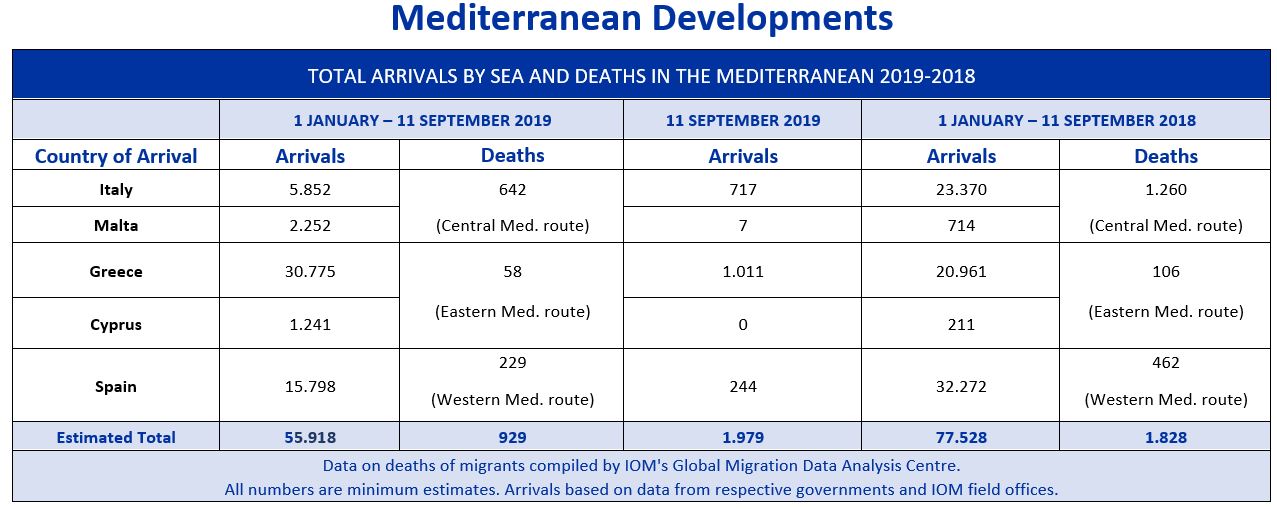-
Who we are
WHO WE AREThe International Organization for Migration (IOM) is part of the United Nations System as the leading inter-governmental organization promoting since 1951 humane and orderly migration for the benefit of all, with 175 member states and a presence in 171 countries.
-
Our Work
Our WorkAs the leading inter-governmental organization promoting since 1951 humane and orderly migration, IOM plays a key role to support the achievement of the 2030 Agenda through different areas of intervention that connect both humanitarian assistance and sustainable development.
What We Do
What We Do
Partnerships
Partnerships
Highlights
Highlights
- Where we work
-
Take Action
Take Action
Work with us
Work with us
Get involved
Get involved
- Data and Research
- 2030 Agenda
Mediterranean Migrant Arrivals Reach 55,918 in 2019; Deaths Reach 929
Geneva – IOM reports that 55,918 migrants and refugees have entered Europe by sea through 11 September, roughly a 30 per cent decrease from the 77,528 arriving during the same period last year.
Arrivals this year to Greece and Spain are at 30,755 and 15,798, respectively, (46,553 combined) accounting for almost 83 per cent of the regional total, with the balance arriving in much smaller numbers to Italy, Malta and Cyprus. Arrivals to Greece are running approximately 47 per cent ahead of 2018’s totals from this time. Arrivals to Spain are more than 50 per cent lower.
Deaths recorded on the three main Mediterranean Sea routes through almost seven months of 2019 are at 929 individuals – or about 51 per cent of the 1,828 deaths confirmed during the same period in 2018.

The 929 deaths at sea do not include several in the past two weeks of several dozen people that were documented on sea routes to Spain. On 29 August, a boat carrying 32 people from the coast of Dakhla to the Canary Islands capsized. Nine survivors were rescued by the Moroccan Navy, but tragically 23 people lost their lives. The remains of only one person were recovered from the sea, which means that 22 people remain missing.
A few days later, on 3 September, two young Algerian men were rescued from waters 40 miles south-east of Cabo de Gata, Almería. They reported that they had left Algeria five days before along with 15 others, but their boat capsized. Spanish authorities activated a search and rescue operation but have not found any further survivors. These 15 people remain missing at sea.
On 1 September, a 16-year-old Moroccan teen died of cardiac arrest at a hospital in Ceuta. He was found unconscious at the port of this Spanish enclave in North Africa. He died shortly after arriving at a local hospital. Authorities surmised the victim was trying to hide inside a ferry bound for the Spanish mainland. In the Eastern Mediterranean, a 65-year-old Syrian woman died in a hospital in Samos shortly after being found unconscious inside a boat intercepted by the Greek coastguard near Kokkari, Samos on 6 September.
Missing Migrants Project
2019 is the sixth year of IOM’s efforts to systematically record deaths on migration routes worldwide through its Missing Migrants Project. Since the beginning of 2014, the project has recorded the deaths of 33,437 people, including 2,275 in 2019 as of 11 September (see chart further below).
Due to the challenges of collecting information about these people and the contexts of their deaths, the true number of lives lost during migration is likely much higher. Missing Migrants Project records should only be viewed as indicative of the risks associated with migration, rather than representative of the true number of deaths across time or geography.
Besides the sea deaths on routes to Europe mentioned above, there were also deaths in Europe itself. On 7 September, the remains of a man were recovered from the Dora river, near Bardonecchia, in Italy’s Piamonte region on the French-Italian border.
In North Africa, 11 Sub-Saharan African migrants lost their lives in a traffic accident on the border between Algeria and Mali on 1 September. Three people were injured but survived. The crash took place in the Algerian province of Adrar, on the road between Bordj Badji Mokhtar and Reggane. On the Myanmar-Bangladesh border, a Rohingya man died in a landmine blast near the border town of Gundrum on 3 September.
On the US-Mexico border, records from the Pima County Office of the Medical Examiner show that the remains of 32 people were found in different locations on the Arizona-Sonora border in July and August. In total, 310 people have lost their lives in 2019 attempting to cross this border. Most recently, on 11 September, a 30-year-old woman from Haiti and her 4-year-old son drowned while crossing the Río Bravo. This is the third drowning incident recorded in the Río Bravo this month (see below).

In total, at least 578 people have lost their lives in the Americas in 2019, compared with 428 recorded through this point in 2018 and 422 in 2017 – an increase over both years of over 35 per cent.
Missing Migrants Project data are compiled by IOM staff based at its Global Migration Data Analysis Centre but come from a variety of sources, some of which are unofficial.
To learn more about how data on migrants’ deaths and disappearances are collected, click here.
The report Fatal Journey Volume 4, published 28 June, includes an overview of five years of Missing Migrants Project data (2014-2018) and an update on what is known about deaths during migration in 2019. For latest arrivals and fatalities in the Mediterranean, click here.
Learn more about the Missing Migrants Project.

See contacts here.
